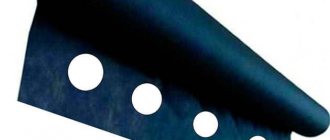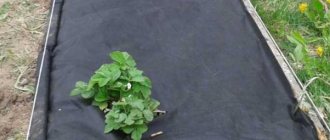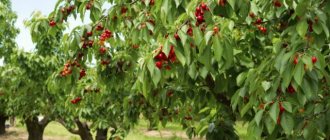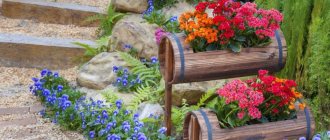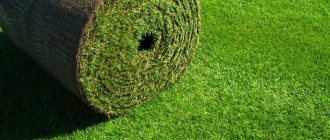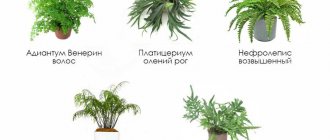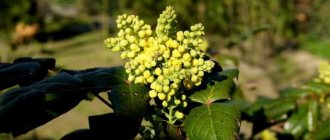Home » Garden
Olga Polyakova 01/29/2020
1112 Views
Temperate climate zones can differ significantly in the timing of the onset of the warm season, as well as its duration.
As you move away from the Atlantic Ocean, its continentality increases - winters become longer and more severe, and less and less time is allocated for the ripening of certain crops in the warm season.
In this regard, there is a need to grow crops not only in the open air, but also in greenhouses.
Features of the use of covering material
Weed control agrofibre is a durable and lightweight raw material made from polymers.
Fabric with breathable properties perfectly allows oxygen to pass through, protects plantings from frost and inhibits the proliferation of harmful plants and fungi. The wear-resistant composition can withstand active use for 7 years. If you lay a dense covering material on the site, the soil under the layer will not be washed away with precipitation. The product does not enter into chemical reactions with fertilizers and poisons, therefore it retains its original qualities for a long time.
Weed control helps growers maintain a well-groomed and attractive lawn. The protective non-woven strip does not harm crops and does not disturb the composition of the soil. Moisture does not evaporate for a long time, which is important for a weekend home. Blocking the entry of ultraviolet radiation will get rid of excess vegetation and protect against frequent weeding.
Mulching beds with covering material is a useful procedure that will make it easier to grow vegetables, berries and flowers. A popular weed killer has advantages over manual loosening:
- Protection from a negative environment. Young plants do not suffer from a lack of moisture or nutrition, and do not die from excessive solar activity. The top soil layer is not compacted and is not destroyed by precipitation or irrigation.
- Optimal conditions for development. A natural microclimate is created under the film, encouraging crops to grow. Pathogenic bacteria do not take root.
- Easy to care for. The protection does not interfere with irrigation or the application of liquid fertilizers.
- Versatility. Covering material can be placed on a garden bed, covering the surfaces of a greenhouse, or laying out a garden path.
- Wear resistance. Agrofibre has a dense structure, so it retains its original appearance and quality for a long time. Manufacturers claim that the products can withstand from 7 to 12 seasons of active use.
In order for the weed covering material to serve for the 7-12 years stated by the manufacturer, the raw materials must be stored correctly. For the winter, the canvas is removed from the bed, the remaining soil is washed off and treated with a fungicide solution. The agrofabric is dried on a clothesline and rolled into a roll without bending the surface. The product can be placed at the bottom of a special box.
We invite you to familiarize yourself with Lightweight greenhouses made of arcs with covering material
Color
Participant kler26 writes the following: “Has anyone used black agrofibre to cover the ground in garden beds to prevent weeds? I had some trouble with him. Maybe I'm doing it wrong. I only water each hole; the water washes away the soil, leaving bare roots. That's why I add soil regularly. The weed also grows under the fiber. you have to stick your hand in and somehow pull them out - it’s very inconvenient. In addition, the fiber periodically pokes out from under the ground, so you have to crawl and cover it with new ones. I thought it would be easier with him, but something turns out to be more troublesome.”
The canvases differ in color, which is also chosen in accordance with the area of application. They are suitable for the following purposes:
- Black. Used in cold regions. They attract sunlight, so the soil warms up faster. Even before planting the plants, the beds are lined with material. After 1-1.5 weeks, the soil becomes suitable for sowing.
- White. Reflects light, preventing weeds from developing. Slots are made in the canvas for plants. Shoots located above the material receive more light.
- Black and white. The canvases are white on one side and black on the other. They are spread directly onto the beds. The black side faces down. This prevents grass from growing. The white side reflects the sun's rays, preventing overheating of the soil and plants. The material is used for vegetable gardens in warm climates. You will need to water and weed the beds less often.
- Green. It is used for near-trunk decoration and for mulching the soil. Creates a beautiful landscape near the house and prevents the germination of weeds.
Cover the potatoes with film
You can plant potatoes in the spring immediately under the film. This will eliminate many of the problems associated with growing this crop and will allow you to get the harvest 3-4 weeks earlier, because:
- the soil under the film warms up faster;
- plant development phases are accelerated and seedlings appear earlier;
- the root system develops very actively, and the tubers are not afraid of frost;
- there is no need for weeding since there are no weeds.
The only drawback of the film covering method is the high cost of the covering material.
To form a bed of potatoes hidden under a film, you need to choose a plot of land oriented to the south, which dries out earlier than the rest in the spring and is protected from strong winds.
Mulching potatoes with film is a fairly popular agricultural technique. Using film, the crop is grown on ridges or in ridges, so when planting, the tubers are not buried, but laid out on the surface of the soil. The aerial part grows through special holes in the film. New tubers also grow on the surface, and to harvest you only need to lift the film. The advantages of this growing method are that the potatoes do not need to be hilled, since light does not penetrate through the impermeable film. It also prevents the germination of weeds and retains moisture in the ground. Plants mulched with film require less organic matter and fertilizers.
How to properly use weed control material
For the use of covering material to be effective, it must be used correctly. Traditionally, the bed is first covered with film or canvas, and then cross-shaped holes are made in it, into which seeds or seedlings are planted. But in practice, it is much easier and more convenient to make small round holes, since the edges of the cross-shaped slots can interfere with the growth of crops (Figure 2).
Figure 2. Application of agrofibre in beds
If you plan to cover a bed with carrots, beets, radishes or other vegetables with agrofibre, the seeds of which are planted directly in the ground, you can simply spread the material on the ground, and when the crops sprout and get stronger, simply remove the cover for the further development of the sprouts.
The correct use of covering material in garden beds looks like this:
- The soil in the garden bed must be carefully leveled and all lumps broken up so that the surface is perfectly flat.
- We lay out the canvas next to the bed and make marks on it for future cuts.
- To make an even circle, you can use a small saucer. Cross-shaped cuts are made with a regular knife. The average distance between the holes is 40-45 cm, but this depends on the type of plants being grown. It is not recommended to reduce the distance between the holes, since planting too densely will deprive the plants of light and air, and they will develop more slowly.
- The canvas prepared in this way is laid out on the garden bed and its edges are secured with pegs, bricks or small stones.
After this, all that remains is to plant the seedlings or seeds in the prepared holes. Caring for crops is also quite simple: since there is no need to loosen and remove weeds, all care comes down to periodic watering and applying fertilizing directly into the holes.
In addition to the technology for using covering material, you need to choose the right type. The modern market offers a wide range of similar products, ranging from black film and agrofibre, to white and colored non-woven fabrics. Each of them has its own advantages and disadvantages, so we will look at the features of using the most popular types in more detail.
Black agrofibre
Black agrofibre has many advantages, so it is not surprising that it is most often used to control weeds (Figure 3).
Of the main advantages of black agrofibre, it is worth highlighting:
- Reduced labor costs and financial costs: weeds simply do not grow under such fabric, so you do not have to spend money on buying herbicides or waste energy on constant weeding.
- Cleanliness of the fruit: if you grow strawberries or other berries under such agrofibre, you do not have to wash them from soil residues, since the fruits are on the surface of the fabric and dirt and sand do not settle on them.
- Acceleration of crop growth: such a coating accelerates seed germination, since the soil under dark agrofibre warms up much faster than in beds without it.
Figure 3. Areas of application of black agrofibre
However, such a fabric is not recommended for use in southern climates, where the soil is strongly heated by the sun. But, if you still want to use black material, then you need to additionally cover it with a layer of light mulch, for example, hay, straw or sawdust.
Two-tone or white fabric
White and two-color agrofibre are also popular. The first type of material can be used in any climatic and soil conditions. Like black, white fabric protects the beds from the germination of weeds, but at the same time allows a sufficient amount of solar heat, air and moisture to reach the cultivated plants (Figure 4).
Figure 4. External features of two-color covering material
A more modern option is two-tone fabric. It appeared on the market relatively recently, but has already proven itself as a reliable protection against weeds. One side of the canvas is white, and the other is black. Such material should be laid with the black side facing the ground and the white side facing out. This will reflect sunlight from the fabric, but at the same time heat will be absorbed by the lower dark side. As a result, plants will receive more heat and grow faster. In this case, ripening occurs evenly, since the roots of young seedlings do not overheat.
Growing cucumbers under film
Film for growing cucumbers has long become one of the mandatory attributes of a successful gardener. The main advantage of the film growing method is that in this case the plants are protected from temperature changes .
When mulching cucumbers with film, follow our tips:
- in April, prepare a nutrient mixture of 1 part compost, peat and sawdust and 2 parts turf soil;
- organize ridges 80 cm wide and passages between them 60 cm wide;
- add mineral fertilizers to the soil: 1 tsp. urea and 2 tbsp. double superphosphate per 1 sq.m. After this, dig the bed to a depth of 25 cm, and on the eve of planting, spill it with warm water at a temperature of up to 50°C, spending 5-6 liters per 1 sq.m;
- cover the bed with black perforated film, cover the ends with earth;
- Make cross-shaped holes in the film and sow cucumber seeds in them or plant grown seedlings.
In hot weather, the film can become very hot. In this case, water it with water in which chalk is diluted.
To grow cucumbers, you can build a mini-greenhouse with a mulch layer and a film cover installed on the frame
Composition and use of covering material
The covering material is made from ethylene polymers by thermoplastic processing under pressure. This makes it possible to obtain a fairly dense artificial fabric that is shock-resistant, transmits light and heat well, does not deform in frost, and has low adhesion.
Thanks to these properties, the covering material is well suited for protecting young seedlings and soil, retaining moisture in the soil, and also helps control weeds.
It is used in several ways:
1. Directly cover the plants with material that rises as the stems grow. To prevent the canvas from flying off, the edges are sprinkled with earth or covered with a wooden beam.
2. Build small arcs over the bed and cover the frame.
3. They build full-fledged greenhouses and cover them with rolled material.
4. Lay it on the ground, and make small cuts for the stems to germinate.
This synthetic substance is used in different seasons. In the spring, they protect young shoots from frequent frosts, which allows you to get cucumbers, tomatoes, strawberries and herbs earlier than usual. In summer, the material prevents the rapid evaporation of moisture from the soil and this reduces the work required to care for plants (frequent watering, hilling).
In the fall, artificial fabric allows you to re-harvest radishes, carrots, strawberries, cucumbers and zucchini, when the nights are already cold and the sprouts do not survive under normal conditions. In winter, covering material is used to protect tubers and seeds remaining in the soil (flower varieties, garlic, strawberry roots). They also cover berry bushes from autumn to spring in harsh regions.
Thanks to its dense structure and interaction with light, the covering material is capable of:
- increase productivity;
- reduce moisture loss in hot weather;
- accelerate fruit ripening;
- reduce labor costs for tillage;
- protect from frost;
- prevent birds from eating the crop;
- neutralize excess ultraviolet radiation.
What is agrofabric, spunbond, black lutrasil?
In our case, we are talking about black agrofabric; green or red agrofabric is less common.
Black agrofabric :
- dense 90, 100, 120 and 130 g/sq.m,
- allows water and air to pass through,
- does not decompose in the soil,
- resistant to chemicals.
Black spunbond density 60 g/sq.m is thinner than agrofabric and cheaper. Has UV protection (SUF marking). Unlike denser agrofabric, you cannot walk on it unless you want to turn the soil underneath into stone! In addition, spunbond deteriorates from frost.
Agrofabric in a flower garden with shrubs and conifers
Black lutrasil or agrofiber with a density of 50-60 g/sq.m is used in the same way as spunbond for mulching. It is less durable than spunbond and even less durable than dense agrofabric.
Spandbond and lutrasil are similar to each other and are used almost identically.
If you want to cover large areas, but want to save money, then put black agrofabric on the paths, and spunbond or lutrasil under the bushes.
Types of covering material
Agricultural weed control fabric is available in several popular varieties on the market. Products differ in density, color and manufacturing method. The characteristics of non-woven material are selected individually to suit the needs of the farmer.
Spunbond
A covering fabric made of polypropylene fibers is created using special equipment. Durable and wear-resistant coating is not afraid of ultraviolet radiation, precipitation and temperature changes. Raw materials are used both in open ground and in greenhouses. Weed spunbond with a density of 50 g/m2 inhibits the growth of harmful vegetation and protects against frost. In regions with cold climates, an option from 60 to 80 g is suitable.
Two-layer covering material is used as mulch and protection from negative weather conditions. The light layer neutralizes excessive exposure to the sun and prevents the plantings from overheating. The lower tier suppresses the development of weeds. Reinforced models with increased strength can be used to create paths in the garden.
White fiber with a density of 17 to 40 g/m2 transmits light, maintains an optimal microclimate, and is therefore suitable only for arranging greenhouses. Spunbond is not afraid of temperature fluctuations ranging from +100 to -50 °C. Weed control products do not react with chemicals and do not release toxins.
Geotextiles
Non-woven covering material is made from polyester fibers. Using thermal bonding, the threads are woven into fabric. The resulting fabric is very strong and allows air to pass through well. Weed control geotextiles are popular due to:
- low cost;
- durability;
- clear installation;
- versatility.
Agrospan
Russian products are almost no different from spunbond in terms of quality and areas of use. Ultraviolet stabilizers protect agrofabric from sunlight. Inexpensive covering material is used when cultivating garden strawberries, strawberries and berry plants. Wear-resistant agrospan can be left for the winter, but it shows the best results when fighting harmful grasses.
Agrotex
The well-known Russian brand offers several types of popular raw materials. The yellow version is used to kill insects on nightshade crops. The use of black geotextile against weeds makes it easier to care for strawberries: during the season, high temperatures do not burn the berries, and soil dirt after watering does not stain the crop.
The perforated surface makes the farmer’s work easier and eliminates the need to manually cut holes for plants. The covering material from the roll does not deform due to temperature changes and suppresses the formation of pathogenic bacteria. It is rolled out on the site and seedlings are placed in the holes.
Agril
Fabric with high air permeability is used to control weeds. Crops do not suffer in the heat and do not freeze in cold weather. Agril protects the soil from crusting and erosion. If you install it correctly on the site, the plants will produce an early harvest. The transparent type has a density of 17 and 40 g/m2, transmits sunlight and is used in greenhouses.
The characteristics of the black covering material are 50 g/m2, so it is suitable for controlling weeds on the site. If you mulch strawberries and vegetables with a cloth, the biological processes in the soil are not interrupted. Oxygen enters the root system, and the humidity level is not disturbed.
Lumitex
Soft corrugated film is available for sale in several colors. Agrofibre converts the sun's rays, leaving only those necessary for plant development, especially in cloudy weather. Reflective properties are suitable for covering cucumbers and strawberries, eliminate dangerous overheating and freezing, and accelerate the ripening of the crop. When equipping greenhouses, a summer resident can combine Lumitex with polyethylene.
Lutrasil
German agrotextiles are produced in two types - spun and non-woven. The first option is used for greenhouses and row spacing, the second can be mulched. The structure of the canvas resembles a thin cobweb. The fabric is breathable, so condensation never forms underneath it. Produced in different density options - from 17 to 60 g/m2.
Black film
Inexpensive covering material is used for mulching beds, and reinforced material is used in landscape design. The product does not allow air to pass through well, so condensation may cause fungi and rot to appear under the layer. The dark upper tier gets very hot from the sun, which is contraindicated for seedlings. Black weed film helps suppress the development of harmful plants. To minimize the negative properties, you need to sprinkle straw on top of the structure.
Advantages and disadvantages
Before making a choice, you need to consider the pros and cons of black covering material. A number of gardeners believe that it is better than white and more reliably copes with the tasks.
The canvas can protect plantings from exposure to unfavorable environments. They are not affected by direct sunlight and precipitation. It also eliminates moisture and nutritional deficiencies. The natural microclimate does not allow pathogenic bacteria to take root; in addition, ideal conditions for growth are created. The seedlings are very easy to care for, fertilize or water them.
It is noted that black covering material is universal. It can be used when organizing greenhouses and greenhouses, for arranging paths or stretching over a bed.
Black film is most often used for the mulching procedure. The product is highly appreciated for its affordable price. Reinforced canvases are popular in landscape design. Weeds practically do not grow under the black film.
However, this product may also have disadvantages. A number of them are associated with improper installation of the product or non-compliance with operating rules. In this case, significant harm can be caused to seedlings, since errors lead to the appearance of condensation, and this can lead to problems such as fungus, and in some cases, plant death.
In addition, black products are subject to strong heat. Since air passage is difficult, this can lead to the formation of rot. To make the negative features less pronounced, gardeners recommend sprinkling the material with straw. In hot areas, you will need to cover the plantings with newspapers or grass. Ultraviolet stabilizers are destroyed after 2 months of use.
